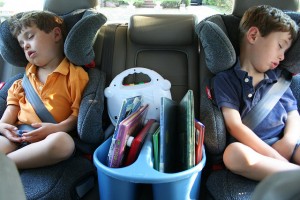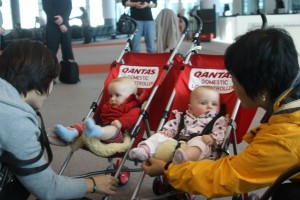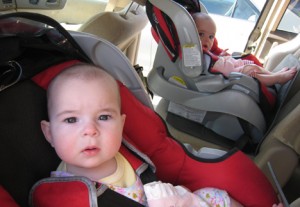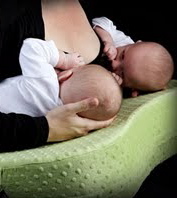Over the river and through the woods, to grandmother’s house we go!
If you’re concerned whether traveling with your infants or toddlers will be a delight or a disaster, I can help with some suggestions after traveling with lots of kids of all ages for quite a few years now.
 Now, although I can’t guarantee that your travels with tots will be necessarily delightful, I can give you some tips that will definitely have you prepared so you’re not ambushed by the unexpected, or have miserable experiences as you travel to and return from your vacation destinations.
Now, although I can’t guarantee that your travels with tots will be necessarily delightful, I can give you some tips that will definitely have you prepared so you’re not ambushed by the unexpected, or have miserable experiences as you travel to and return from your vacation destinations.
Tips for Traveling with Twins
When I traveled (as a solo-parent) with four young children by air from Florida to California (with a connection in Atlanta), I found that the following system worked beautifully:
• Allow each child over 3 years of age to pack up his or her own special backpack. Pack it with coloring books and crayons, hand-held video games (with volume control), magna-doodles, special toys including a “lovey”, a small travel pillow, and favorite snacks (specially chosen by each specific child) so that these feel comfortable, are kept busy, and happily occupied!
• If any of your children have ever displayed even the slightest tendency toward motion-sickness, I would HIGHLY RECOMMEND that you give him/her/them a chewable, 12-hour-lasting motion sickness medication such as Children’s Bonine or the less-drowsy formula of Children’s Dramamine approximately 30-minutes before starting to travel. I am not recommending that you “drug” your children, but to avoid motion sickness and all the joy and drama that goes along with it, I always made sure to give my “easily-queezy” little ones that dose of prevention!
 • If traveling by air, you’ll need to bring the double stroller for all of the walking you’ll do through the airports, etc. Your stroller (along with other passengers’ strollers) will be loaded onto the plane after you board, and will be available for you as you exit the plane. You’ll need to baggage-check their car seats or stroll your babies in the rolling carts for car seats that are popular today, because you’ll need your car seats with you for traveling locally when you arrive at your destination. If you prefer to strap your babies into car seats in individual airplane seats, you may have to buy a separate ticket for them, which is why most decide to travel with their babies in their arms/laps. When on the plane, allow the older children a bit of independence by encouraging them to get up (when permitted), stretch their legs, and use the restroom by themselves. It may sound like much of an adventure from an adult’s perspective, but my children thought it was a blast!
• If traveling by air, you’ll need to bring the double stroller for all of the walking you’ll do through the airports, etc. Your stroller (along with other passengers’ strollers) will be loaded onto the plane after you board, and will be available for you as you exit the plane. You’ll need to baggage-check their car seats or stroll your babies in the rolling carts for car seats that are popular today, because you’ll need your car seats with you for traveling locally when you arrive at your destination. If you prefer to strap your babies into car seats in individual airplane seats, you may have to buy a separate ticket for them, which is why most decide to travel with their babies in their arms/laps. When on the plane, allow the older children a bit of independence by encouraging them to get up (when permitted), stretch their legs, and use the restroom by themselves. It may sound like much of an adventure from an adult’s perspective, but my children thought it was a blast!
• On a road trip, try to leave as early as possible after getting as much sleep as possible. I also recommend packing up easy meals so that you don’t have to rely on finding fast food (or paying out of the nose for it). The night before traveling, I make a sandwich for each person (who eats table food) for two meals, pack the ice chest with the sandwiches, fruit, crackers, chips, juice boxes, yogurt, etc. I’m always careful to pack plastic spoons or forks as needed, and plenty of paper plates and paper towels. Stop every few hours for a chance to get out, go to the restroom, have a picnic lunch, run around and release some energy. Plan stops where you can find a park, or even just a rest-stop with some open space (but watch for land minds left by traveling doggies!).
Tips for What to Bring on Road Trips
 On road trips (which is our most-used method of travel now that there are eight of us … nine if you count our new pooch Simon, and not counting our cat Shannon, since she stays home and is cared for by a neighboring, trusted teenager), I pack us as efficiently as possible, and allow easy reach within the vehicle the following important items:
On road trips (which is our most-used method of travel now that there are eight of us … nine if you count our new pooch Simon, and not counting our cat Shannon, since she stays home and is cared for by a neighboring, trusted teenager), I pack us as efficiently as possible, and allow easy reach within the vehicle the following important items:
• The pack-n-play sleepers for my toddlers for their sleeping accommodations in hotels and at Grandma’s house;
• snap-on-table high/booster chairs for restaurants (so you’re not using the establishment’s “icky” ones);
• LOTS of hand sanitizer, sanitizing wipes, baby wipes, paper towels and plastic (left-over grocery bags) for garbage, food wrappers, and in the event that the Dramamine failed or wasn’t given to someone who probably needed it. For babies/toddlers, pack that diaper bag with at least one full change of clothing for each baby and enough diapers to last a whole day.
• One full day’s worth of baby foods (with bibs and spoons) and/or formula for non-breastfeeding moms.
• Medications and first aid supplies such as pain reliever, bandages, antibiotic ointment, decongestant, cough suppressant, antacids, lip balm, moisturizing skin lotion (as traveling tends to dry out our skin), and any medications specifically needed by each person.
• Plenty of water for each person.
(Be aware that if traveling via air, you will not be able to carry on any bottled liquids larger than 3 ounces, but this excludes pre-filled baby bottles, nursery water, baby-specific medications such as Mylicon (simethicone drops for gas relief, but this is usually in 1/2-oz. bottles). Water and other beverages will be provided by the flight crew once the aircraft reaches cruising altitude. I’ve always found flight crews to be very accommodating to us with our family’s needs.
Travel tips for breastfeeding moms
Whether you’re traveling by ground or air, you know you’ll need to feed your babies every three hours or on demand, regardless of where you happen to be when feeding time arrives, so make sure you carry along with you:
• your nursing pillow(s)/boppie pillow;
• a portable, battery-operated or manual breast pump/bottles with nipples and caps (and cold pack, insulated carrying case);
• privacy blankets and burp cloths;
• nursing pads, and extra bra and shirt/blouse for you in the event the babies’ feedings are delayed here and there.
 Obviously, you cannot breastfeed in a moving car because the babies need to remain safely buckled into their car seats, and you need to stay buckled up as well, so make the most of your rest stop nursing time by doing double-up (tandem) feedings. If you have older children, have Daddy take them off for a bit of leg-stretching and energy-releasing exercise so you can have some quiet time with the babies.
Obviously, you cannot breastfeed in a moving car because the babies need to remain safely buckled into their car seats, and you need to stay buckled up as well, so make the most of your rest stop nursing time by doing double-up (tandem) feedings. If you have older children, have Daddy take them off for a bit of leg-stretching and energy-releasing exercise so you can have some quiet time with the babies.
I found that sitting in a back seat of the vehicle with my support pillow(s) across my lap gave great support. Taking this twenty minute quiet time away from the continuous motion and noise of the vehicle to allow the babies (and yourself) a good feeding will be very relaxing and you’ll find it to be a very-needed break. You’ll all become relaxed and ready for the next 3 hours of travel before the next feeding.
Nursing on an airplane is a bit more challenging, especially as you try to keep the crying babies quiet. We may say that we don’t care about the glaring, irritated looks from the other passengers, but we do care. Settling your babies down by comforting them at the breast is the perfect solution to ease their fears, calm their anxieties, and warm their tummies. To tandem feed, lift up the armrest between two seats and sit between the two, providing room for you to comfortably feed both babies. If the aircraft is completely full, as it probably is during the holidays, you may have limited space and will to get creative with a cross-over feeding position for both babies, or feed them separately (feeding the fussier one first!)
Whether you plan to travel by air or ground, being completely prepared and ready for anything (because those what-if’s are bound to happen) will alleviate stress and anxiety for the whole family, and allow your whole vacation to be remembered with fond memories.
If you find these tips helpful for you, please share this article on to other families with multiples, or just a few kids or more!
SAFE TRAVELS!

